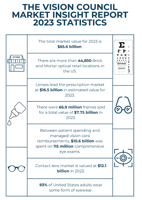📈 Some interesting stats about the US Vision Care industry for 2023 from theThe Vision Council🔥
𝐒𝐭𝐞𝐩𝐡𝐞𝐧 𝐍𝐞𝐝𝐨𝐫𝐨𝐬𝐜𝐢𝐤 𝐇𝐢𝐠𝐡𝐥𝐢𝐠𝐡𝐭𝐬 𝐒𝐭𝐫𝐚𝐛𝐢𝐬𝐦𝐮𝐬 𝐚𝐧𝐝 𝐂𝐨𝐥𝐨𝐛𝐨𝐦𝐚 𝐚𝐭 𝐭𝐡𝐞 2024 𝐎𝐥𝐲𝐦𝐩𝐢𝐜𝐬
🤸 Stephen Nedoroscik has made headlines at the 2024 Olympic Games by bringing much-needed awareness to strabismus and coloboma. On July 29, his remarkable performance on the pommel horse helped the US men’s gymnastics team secure a bronze medical.
👀 Nedoroscik competes with both strabismus – a condition where one eye may be misaligned or move intermittently—and coloboma, a condition where part of the eye’s structure doesn’t fully develop, leading to heightened light sensitivity. These conditions, while relatively common, have rarely received such mainstream attention.
🎙️ According to Terri A. Gossard, OS, MS, national medical director of clinical integration for EyeCare Partners, Nedoroscik’s success is a testament to the power of practice and visualization. Gossard explains, “Strabismus can vary from subtle to noticeable, and in Stephen’s case, he can choose which eye to use for fixation.”
👁 Coloboma, which affects the eye’s formation during development, adds another layer of challenge. Nedoroscik’s ability to perform at such a high level despite his heightened light sensitivity is nothing short of extraordinary.
🏆 Stephen Nedoroscik’s achievements at the Olympics are not just a personal triumph but a significant moment in raising awareness about these ocular conditions.


